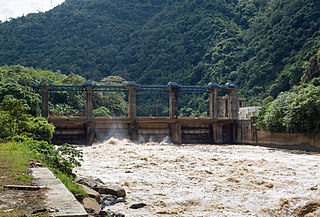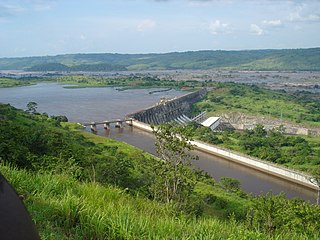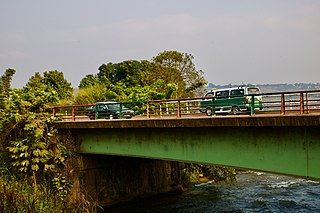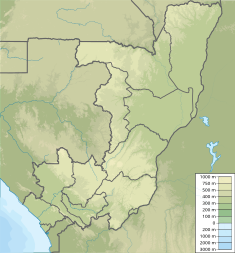Technical
The Moukoukoulou hydroelectric power station includes a concrete dam with a free spillway, a water intake fitted with fine grids, head valves, supply and penstock pipes, a plant and an outdoor station. The nominal drop height is 68 metres (223 ft). The power plant has four 18.5 megawatt turbine/generator sets, giving total power of 74 megawatts. There are two 45 megavolt-ampere transformers, with two sets per transformer. The output voltage is 11 kilovolts and discharge voltage is 110 kilovolts. The electricity is fed into the transmission network which includes 110 kV transformer stations at Bouenza Il, Nkayi and Loudima, and 35 kV transformer stations at Loutété, Madingou and Dolisie.
In 1985 the plant had a maximum energy output of 400 GWh/year, but only half of that was being absorbed by the network due to lack of a connection to Brazzaville. [3] About 240 GWh was generated in the wet season, and 160 GWh in the dry season. [4] During the low water period of June, July and August the guaranteed power output is no more than 30 MW. A 2004 report recommended creation of a water retention structure to guarantee full power output throughout the year.
History
The Moukoukoulou hydroelectric power plant is the most important in the country. Construction started under the presidency of Marien Ngouabi within the Sino-Congolese cooperation framework. The dam was built by Chinese technicians in 1974. The power plant was commissioned in 1979. At completion, it became the Republic of Congo's largest hydroelectric power source. [8] : 53
A 1988 UNDP / World Bank report noted that the Moukoukoulou power plant was in a deteriorating condition. [9] A single 225 kW/110 kV line linked Moukoukoulou to Pointe-Noire, so that city was vulnerable to power failures. [10] The Société Nationale d'Electricité (SNE) had two independent networks, one centered on Brazzaville and the other on Pointe-Noire. [11] A 225 kV line linking the networks was expected to be operational by late 1988. This would allowing surplus capacity from Moukoukoulou to be directed to Brazzaville and reduce the need for imports from Zaire. [11] Extensive work was needed at Moukoukoulou on the ancillary equipment and other problems had to be resolved to improve output and reliability. [10]
In April 1998 Cocoye insurgents captured the Moukoukoulou Hydroelectric Dam, killing several employees and cutting off the electric supply to Pointe-Noire for several weeks. The plant was damaged, and since then only provided 25 MW. In April 2002 a mutiny by 21 government troops demanding payment of their salaries led to power being cut from the Moukoukoulou dam. This caused an electricity blackout in the south of the country. On 2 May 2002 the troops were dismissed from the army.
A 2005 OECD report noted that during the civil war the hydroelectric plants had been badly damaged, and there were severe shortages of water and electricity. The equipment of the SNE was decrepit and operating at only 1/3 of its capacity. Repairs to the high-voltage line between Moukoukoulou and Brazzaville were expected to start soon.
In May 2007 President Denis Sassou Nguesso visited Moukoukoulou, where all four turbine generators had been rehabilitated at a cost of US$12 million, although work on the transformers was still not complete. Damage to the transmission network was preventing its power from reaching Brazzaville, which was relying on power from the Inga plants in the Democratic Republic of Congo. The rehabilitation work was carried out by Chinese technicians with funding of 6 billion CFA francs from the Congolese government.
In 2017 the SNE president Eugène Ondzambe Ngoyi asked the government to fund a general overhaul of the equipment at Moukoukoulou. Since 1979 there had been only three general overhauls in 34 years, although the recommended frequency was every four years. On 29 July 2018 the SNE was dissolved and its assets and staff were transferred to the new limited company Energie Electrique du Congo (E2C). In October 2018 the Ministry of Energy and Hydraulics invited expressions of interest from private companies to rehabilitate, modernize and operate the Moukoukoulou hydroelectric power station.

Pointe-Noire is the second largest city in the Republic of the Congo, following the capital of Brazzaville, and an autonomous department and a commune since the 2002 Constitution. Before this date it was the capital of the Kouilou region. It is situated on a headland between Pointe-Noire Bay and the Atlantic Ocean. Pointe-Noire is the main commercial centre of the country and has a population of 1,420,612 inhabitants in 2023.

The electricity sector in Canada has played a significant role in the economic and political life of the country since the late 19th century. The sector is organized along provincial and territorial lines. In a majority of provinces, large government-owned integrated public utilities play a leading role in the generation, transmission, and distribution of electricity. Ontario and Alberta have created electricity markets in the last decade to increase investment and competition in this sector of the economy.

The net capacity factor is the unitless ratio of actual electrical energy output over a given period of time to the theoretical maximum electrical energy output over that period. The theoretical maximum energy output of a given installation is defined as that due to its continuous operation at full nameplate capacity over the relevant period. The capacity factor can be calculated for any electricity producing installation, such as a fuel consuming power plant or one using renewable energy, such as wind, the sun or hydro-electric installations. The average capacity factor can also be defined for any class of such installations, and can be used to compare different types of electricity production.

Tenom Pangi Dam is a hydroelectric plant in Tenom, Sabah, Malaysia. It is located 120 km (75 mi) south of Kota Kinabalu on the Padas River. The project is a run-of-river hydroelectric power plant. Tenom Pangi Dam is the only major hydroelectric dam in Sabah.

The Democratic Republic of the Congo was a net energy exporter in 2008. Most energy was consumed domestically in 2008. According to the IEA statistics the energy export was in 2008 small and less than from the Republic of Congo. 2010 population figures were 3.8 million for the RC compared to CDR 67.8 Million.

Alpiq is an internationally active energy group headquartered in Lausanne, Switzerland. The company was established in 2009 after the merger of Atel Holding AG and EOS S.A..

Despite the historic usage of wind power to drain water and grind grain, the Netherlands today lags 21 of the 26 other member states of the European Union in the consumption of energy from renewable sources. In 2022, the Netherlands consumed just 15% of its total energy from renewables. According to statistics published by Eurostat, it was the last among the EU countries in the shift away from global warming-inducing energy sources. The leading renewable sources in the country are biomass, wind, solar and both geothermal and aerothermal power. In 2018 decisions were made to replace natural gas as the main energy source in the Netherlands with increased electrification being a major part of this process.
Oil and Gas dominate the resource sector of the Republic of the Congo, also referred to as Congo-Brazzaville, with the petroleum industry accounting for 89% of the country's exports in 2010. As of June 22, 2018, is a full member of the Organization of the Petroleum Exporting Countries (OPEC), and among African crude oil producers in 2022, The Congo ranked sixth. Nearly all of the country's hydrocarbons were produced off-shore.
The Kiymbi Dam is a major hydroelectric dam and power station that was opened on the Kiymbi river in 1959. It has been neglected and requires rehabilitation.

China–Republic of the Congo relations refer to the bilateral relations between China and Republic of the Congo. On September 10, 1960, Republic of the Congo and the Republic of China (Taiwan) established diplomatic relations. On February 22, 1964, the Republic of Congo switch recognition to the People's Republic of China as the sole legitimate government of China.

The electricity sector of Kosovo relies on coal-fired power plants and is considered one of the sectors with the greatest potential of development. The inherited issues after the war in Kosovo and the transition period have had an immense effect on the progress of this sector.

The Nangbeto Dam is an embankment dam on the Mono River in the Plateaux Region of Togo. It was constructed between 1984 and 1987 for the purpose of providing hydroelectric power to both Togo and Benin as well as creating fisheries and supplying water for irrigation. The dam's 65.6 megawatts (88,000 hp) power station was commissioned in June 1987. The project was financed by the World Bank and African Development Bank at a cost of US$98.22 million.

By the end of 2016 Austria already fulfilled their EU Renewables Directive goal for the year 2020. By 2016 renewable energies accounted to 33.5% of the final energy consumption in all sectors. The renewable energy sector is also accountable for hosting 41,591 jobs and creating a revenue of 7,219 million euros in 2016.
Eranove is a French company active in the management of public services and in the production of electricity and drinking water in Africa. The company was formerly known as Finagestion.

The Djoué River is a river of the Republic of the Congo. It is a right tributary of the Congo River.

The Bouenza River is a river of the Republic of the Congo. It is a right tributary of the Niari River. It feeds the Moukoukoulou Hydroelectric Power Plant.
The Liouesso Hydroelectric Power Station is a 19.2 megawatts (25,700 hp) hydroelectric power station in the Republic of the Congo. The government-owned power station was commercially commissioned in May 2017. Constructed by the China Gezhouba Group, the renewable energy infrastructure project cost approximately US$110 million to construct.
Nyemanga Hydroelectric Power Station is an 1.44 megawatts (1,930 hp) run-of-the-river hydroelectric power station in the Bururi Province of Burundi.
This page is based on this
Wikipedia article Text is available under the
CC BY-SA 4.0 license; additional terms may apply.
Images, videos and audio are available under their respective licenses.













